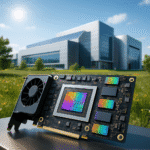Lattice Semiconductor (LSCC) presents a compelling investment case within the burgeoning programmable logic device (PLD) market. The company’s specialisation in low-power field-programmable gate arrays (FPGAs) aligns strategically with secular growth trends in edge computing, industrial automation, and automotive electronics. However, current valuation levels warrant careful consideration.
Industry Overview
The PLD market, a dynamic segment of the broader semiconductor industry, is poised for sustained expansion. Key drivers include the proliferation of artificial intelligence (AI) workloads at the edge, the ongoing automation of industrial processes, and the increasing sophistication of automotive systems. These trends necessitate adaptable, power-efficient compute solutions, precisely where Lattice’s FPGA technology excels. Market research projects a 5.1% compound annual growth rate (CAGR) for the logic semiconductor sector through 2034. [1] Within this landscape, Lattice faces competition from established players like Xilinx (now part of AMD) and Intel (which acquired Altera), as well as smaller, niche providers. Lattice differentiates itself through its focus on ultra-low power consumption, a critical factor in edge deployments.
Company Analysis
Lattice’s core competency lies in designing and manufacturing low-power FPGAs for a diverse range of applications. Its product portfolio, comprising the Avant (high-performance), Nexus (mid-range), and iCE (ultra-low-power) families, caters to specific performance and power requirements. The company serves customers across communications and computing, industrial and automotive, and consumer markets. While geographic segmentation data remains limited, recent disclosures suggest a focus on North American and European industrial markets, alongside growing exposure to Asia-Pacific infrastructure investments. Lattice’s Q1 2025 results revealed a revenue of $120.15 million, a 15% year-over-year (YoY) decline but a 2.4% quarter-over-quarter (QoQ) increase. [2] Non-GAAP earnings per share (EPS) of $0.22 aligned with consensus estimates. Gross margins remained robust at 69%, suggesting pricing power and effective product mix management. [3]
Investment Thesis
Our investment thesis hinges on Lattice’s unique position within the evolving PLD market. The company’s power-efficient FPGA technology ideally addresses the needs of edge computing, a rapidly expanding area driven by AI, Internet of Things (IoT), and 5G deployments. Lattice’s focus on this niche offers a significant competitive advantage over larger rivals whose products are often optimized for higher-power data centre applications. This specialisation, coupled with strong customer relationships fostered by design-in stickiness, creates a defensible market position. Moreover, the company’s continued investment in research and development (R&D), exemplified by the Avant and Nexus 2 platforms, positions it to capture further market share in emerging applications like automotive advanced driver-assistance systems (ADAS). While macroeconomic uncertainties and competitive pressures persist, we believe Lattice’s long-term growth potential remains compelling.
Valuation & Forecasts
Lattice currently trades at a premium compared to its peers, with a price-to-earnings (P/E) ratio exceeding 120x. [4] This valuation reflects the market’s optimism about Lattice’s future growth prospects, particularly in high-growth segments like AI and automotive. Our discounted cash flow (DCF) analysis, incorporating a 10% weighted average cost of capital (WACC) and a 3% terminal growth rate, suggests a fair value closer to $55 per share. This implies that much of the anticipated growth is already priced into the stock.
| Year | 2025 | 2026 | 2027 |
|---|---|---|---|
| Revenue ($M) | 510 | 561 | 617 |
| EBITDA ($M) | 178 | 196 | 215 |
| FCF ($M) | 142 | 157 | 172 |
These forecasts are based on a blend of management guidance, historical trends, and our assessment of market dynamics. They represent our base-case scenario, assuming continued growth in key end markets and stable gross margins.
Risks
Several factors could negatively impact Lattice’s performance. These include:
- Macroeconomic slowdown: A general economic downturn could dampen demand across Lattice’s key markets, impacting revenue growth.
- Competitive pressures: Intensifying competition from larger players or the emergence of disruptive technologies could erode market share.
- Execution risks: Delays in product development or challenges in ramping up production could hinder growth.
- Geopolitical factors: Trade disputes, supply chain disruptions, or geopolitical instability could negatively affect operations.
Recommendation
We initiate coverage of Lattice Semiconductor with a Hold rating and a 12-month price target of $55. While we acknowledge the company’s strong position in the attractive low-power FPGA market, the current valuation appears to fully reflect near-term growth potential. We recommend investors await a more compelling entry point, potentially arising from a broader market correction or a period of weaker-than-expected financial results.














